When my family moved to Norway from Scotland, we took the opportunity to dejunk our lives. We hired a skip. We filled it. We hired another one and filled that too. We visited the charity shops with bags full of clothes and wedding presents we had never used. We went to the local rubbish dump with the things which wouldn’t fit in the second skip. We went to the charity shop with bags of toys, more clothes, our artificial Christmas tree (we were on first name terms by then). Anything we could sell – cars, furniture - we sold. Anything we could give away, we gave away.
When we moved, we took the kids, the animals (all nine of them) and the basics we needed for day to day life in the very small cabin we would live in while we built our new house. And we also took something else: fifty boxes of books.
I don’t know exactly how many books I have. My husband, who built the shelves for them, says probably around three thousand. That was when we moved into that newly finished house. He needs to make more shelves now.
Some would call me a book hoarder and predict Discovery Home and Leisure scenarios: the well meaning venturing between the teetering piles to reason with me. Deep within my papery burrow, me refusing to budge. A backhoe summoned to dig me out, while my family fills a slot on Dr Phil, tissues dabbing.
Or perhaps not. I’ve given away easily as many books as I’ve kept. My collection is the evidence of a lifelong reading habit, not a pathology, and as I make a living from writing about them, it only seems sensible to hang on to those which I might want to refer to again. These, eventually, I may give away too.
But there are others I will always keep. Perhaps one box out of the fifty. When they take me to my grave, they’ll have to find room in my coffin for these. For I read them when I was young and now they are a part of me.
Comet in Moominland by Tove Jansson
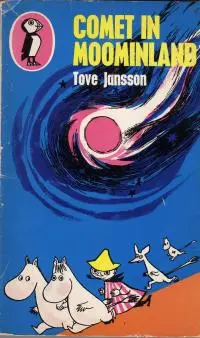 Painter, Swedish speaking Finn, and openly lesbian long before gay rights were a twinkle in Harvey Milk’s eye, Tove Jansson was much more than just a children’s author, yet it’s the Moomintroll books which form her enduring legacy. Comet in Moominland is the second in the series; the first I read, the copy given to me by a Swedish grandmother who hated me in the special way only Swedish grandmothers can. ‘I suppose you’ve already read it,’ she said and threw the book in my lap. I was seven and I hadn’t. Despite the book’s provenance (this was the grandmother who had, on at least one occasion, attempted to kill me) I read the opening pages and was enraptured.
Painter, Swedish speaking Finn, and openly lesbian long before gay rights were a twinkle in Harvey Milk’s eye, Tove Jansson was much more than just a children’s author, yet it’s the Moomintroll books which form her enduring legacy. Comet in Moominland is the second in the series; the first I read, the copy given to me by a Swedish grandmother who hated me in the special way only Swedish grandmothers can. ‘I suppose you’ve already read it,’ she said and threw the book in my lap. I was seven and I hadn’t. Despite the book’s provenance (this was the grandmother who had, on at least one occasion, attempted to kill me) I read the opening pages and was enraptured.
This is the most dramatic of the series and weirdly prescient of the environmental precipice now yawning before us. A comet heads towards the Earth. The sky turns red. The forests are ripped apart by tornadoes. Plagues of grasshoppers descend. Even the sea dries up.
It’s almost as though Jansson, gazing at the rest of us from the tiny island where she summered, knew what a bollocks we were making of the world. If she did, I certainly didn’t and I read it for the gentle humour, the wistful, longing nature of the characters (who always wanted those things they could not quite have – an emotion I instantly identified with) and the wonderful illustrations. Yet the subtext resonated: value what you have, because a twist of fate can take it all away – and if that is Jansson’s legacy to me, it’s probably quite appropriate.
Bottersnikes and Gumbles by S A Wakefield
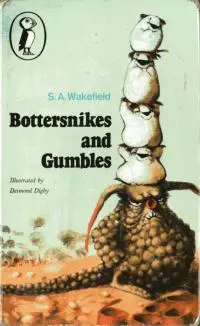 With her stories, Jansson had introduced me to wry humour: prepared me, you might say, for something a little more robust. When this little gem came along, about a year later, I was ready.
With her stories, Jansson had introduced me to wry humour: prepared me, you might say, for something a little more robust. When this little gem came along, about a year later, I was ready.
Bottersnikes and Gumbles takes place far from the pine forests of Moominland. S A Wakefield’s eponymous creatures live in Australia, in the outback. Or more specifically, in rubbish dumps in the outback. You could think of this series as an antipodean version of The Wombles. Certainly the Gumbles, who are cheery and harmless and spend their time constructing useful things out of rubbish, bear a passing resemblance to Tobermory, Orinoco et al. But any Womble venturing into Bottersnike territory would suffer the same fate as an Arsenal fan wandering into a Millwall pub and ordering a pint of best bitter. The Bottersnikes are the jackbooted skinheads of the kid’s fiction world. Evil, lazy and possessed of low cunning, the Bottersnikes’ dream is to capture the Gumbles and enslave them, so they never have to do a stroke of work again.
What Jansson did for the environment, Wakefield did for human rights. Aged nine, I learned how the mind of a slave-owner works: they deserve it, they’re not the same as us, we’re better than them. I also learned that the only way the small, good natured and helpless Gumbles could ever hope to beat the Bottersnikes was by banding together and forming one huge Gumble. And thus, a nine-year-old Trade Unionist was born.
A Wrinkle in Time by Madeleine L’Engle
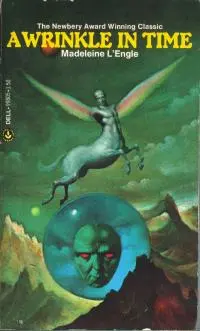 And after my introduction to the basics of Communism, it was time to learn something about the Universe. That Christmas I asked Santa for books. He responded handsomely, but being pressed for time, wrapped them all in one big parcel, rather the way my mother, busy with a full time job, would have. No matter. Amongst the treasures, one book stood out.
And after my introduction to the basics of Communism, it was time to learn something about the Universe. That Christmas I asked Santa for books. He responded handsomely, but being pressed for time, wrapped them all in one big parcel, rather the way my mother, busy with a full time job, would have. No matter. Amongst the treasures, one book stood out.
I loved this book so much, I bestowed one of my precious ‘Puffin Library’ labels upon it, just in case I left it at school and someone tried to steal it. I’m not the only person who became bewitched by L’Engle’s deceptively simple tale about a trio of youngsters who bend space and time to find a lost scientist-father. A Wrinkle in Time is one of those books that regularly crops up on ‘kids books for adults’ lists and the reason isn’t difficult to pinpoint. This is a story stuffed with complex concepts made dazzlingly clear. The space-time continuum, black holes, Euclidean geometry, theory of mind – they’re all in there, used by L’Engle to underpin a ripping yarn of the unputdownable kind.
The mystery and majesty of the Einsteinian Universe revealed, that same year another book introduced me to more science fiction, but of a much darker hue…
Trillions by Nicholas Fisk
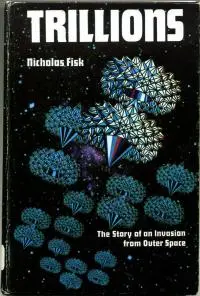 What if one day tiny crystals started falling from the sky? What if those crystals were not natural, but engineered in such a way that they could combine into structures? What if those same crystals, at first apparently harmless, began to combine at will and began to mimic our buildings, our artifacts, our signs? What if they began to imitate our weapons?
What if one day tiny crystals started falling from the sky? What if those crystals were not natural, but engineered in such a way that they could combine into structures? What if those same crystals, at first apparently harmless, began to combine at will and began to mimic our buildings, our artifacts, our signs? What if they began to imitate our weapons?
Trillions took Cold War paranoia and translated it into a scenario which would chime with children. Trillions were just like lego, except this lego could build itself, the way you secretly suspected lego did when your back was turned. Trillions is Toy Story with politics, because when the grown ups discover the toys have minds of their own, they do what grown ups do: load up the assault rifles and trundle out the nuclear arsenal. Fisk’s story captures the overreaction and panic of the adult world as seen by children and, in common with all great scifi, posits an alien life form which is similar to, but subtly different from anything found on this planet. As with A Wrinkle in Time, the concepts in Trillions are heavy duty: a self assembling particle which bears a strong family resemblance to DNA, nano-technology, hive intelligence, cloud computing, global instability. I lapped it up and nagged my mother for a subscription to Understanding Science magazine (granted, reluctantly, we ended up with the whole series and she still has them on her shelf) and dug out my grandfather’s microscope with which I would discover what a hair looks like close up and that snowflakes melt before you get a chance to focus on them.
The Family Nobody Wanted by Helen Doss
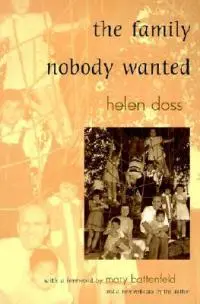 Fast forward two years and I was at boarding school. Twelve years old, parents in the throes of a divorce so messy the other girls, treated to spectacular family melt downs on visiting day, avoided close contact with me, in case emotional trauma were catching. Come the end of term, I waited impatiently for the taxi to take me to the station. Although home had become as restful and secure as the Somme, at least the people there spoke to me. My train, naturally, departed after all the others. Everyone else left. I went to the library (my boarding house was the kind of place where they banged a gong for lunch and we did our prep in the library) and searched through the memoirs of country vicars and books about India for something, anything I might actually want to read.
Fast forward two years and I was at boarding school. Twelve years old, parents in the throes of a divorce so messy the other girls, treated to spectacular family melt downs on visiting day, avoided close contact with me, in case emotional trauma were catching. Come the end of term, I waited impatiently for the taxi to take me to the station. Although home had become as restful and secure as the Somme, at least the people there spoke to me. My train, naturally, departed after all the others. Everyone else left. I went to the library (my boarding house was the kind of place where they banged a gong for lunch and we did our prep in the library) and searched through the memoirs of country vicars and books about India for something, anything I might actually want to read.
This was the book I found. Tucked away on top of books bound in blue cloth. Helen Doss’ account of how she adopted twelve children, most of mixed race and therefore considered unadoptable, is the kind of Readers’ Digest friendly, feel good tale that you can imagine the likes of Disney spurning on the grounds that it is too sentimental. Worse than that, Helen Doss was a devoted Christian, married to a Methodist minister, who saw every turn of good fortune as evidence of God’s Plan. Already dubious about invisible patriarchs in the sky (whose wonderful Plan had landed me with the Swedish Grandmother) Doss’ cheery certainties about Jesus and Love should have made me snigger or at least shove the book back on the shelf for some other homesick kid to find. Instead I wolfed it down, sneaked it into my luggage and claimed it as my own. I must have read it tens of times and even flicking through it for this piece, found myself lost in the story again.
Why? Because at that precise moment, it gave me what I needed: simple reassurance that my parents might stop hating each other and return to loving me. I absorbed the message and when I need a top up (which I still do from time to time), The Family Nobody Wanted, along with all the others, is on my shelf, ready to oblige.
Which childhood books will you never be parted from, and why?
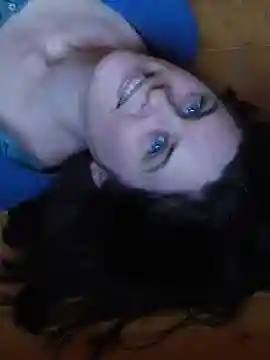
About the author
Cath Murphy is Review Editor at LitReactor.com and cohost of the Unprintable podcast. Together with the fabulous Eve Harvey she also talks about slightly naughty stuff at the Domestic Hell blog and podcast.
Three words to describe Cath: mature, irresponsible, contradictory, unreliable...oh...that's four.







